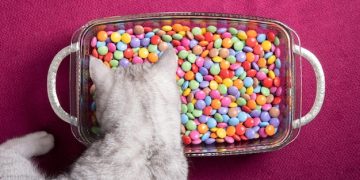Is Your Pet Bored? 10 Enrichment Activities to Stimulate Their Mind

Is your pet showing signs of boredom? This article provides ten engaging enrichment activities to stimulate your pet’s mind, promote physical activity, and reduce behavioral issues, ensuring a happier and healthier companion.
Do you ever wonder if your furry friend is feeling a little… blah? Just like us, pets can experience boredom, leading to destructive behaviors, excessive barking, or general listlessness. But don’t worry, there are plenty of ways to combat pet ennui! Let’s explore is your pet bored? 10 enrichment activities to stimulate their mind, and turn that frown upside down.
Understanding Pet Boredom and Its Effects
Recognizing boredom in pets is the first step to addressing it. Pets, especially those bred for specific tasks, require mental and physical stimulation. Without adequate enrichment, they may develop undesirable behaviors or even suffer from stress and anxiety.
Boredom can manifest in various ways, from excessive grooming to destructive chewing. Understanding these signs is crucial for providing the right kind of enrichment.
Signs of Boredom in Pets
Several telltale signs can indicate that your pet is bored. These signs vary depending on the type of animal, but some common indicators include:
- Increased sleeping or inactivity.
- Destructive behavior such as chewing furniture or digging.
- Excessive barking or meowing.
- Overgrooming, leading to skin issues.
Addressing these behaviors isn’t just about stopping the unwanted actions; it’s about fulfilling your pet’s need for stimulation.

Negative Impacts of Boredom
The consequences of pet boredom extend beyond simple behavioral issues. Prolonged boredom can lead to:
- Depression and anxiety.
- Compulsive behaviors.
- Reduced appetite or overeating.
- Weakened immune system due to stress.
Providing enrichment is not just a luxury; it’s a vital part of responsible pet ownership.
By identifying boredom early and implementing appropriate enrichment activities, you can significantly improve your pet’s quality of life and prevent potential health and behavioral problems.
1. Puzzle Toys: Engaging Their Minds
Puzzle toys are fantastic tools for mental enrichment. These toys require pets to solve problems to access treats or food, stimulating their minds and providing a sense of accomplishment.
There’s a wide variety of puzzle toys available, catering to different levels of intelligence and persistence. Start with simpler puzzles and gradually increase the difficulty as your pet becomes more adept.
Types of Puzzle Toys
Puzzle toys come in various forms, including treat-dispensing balls, sliding puzzles, and hidden compartment games. Some popular options include:
- Treat balls that release food as they roll.
- Sliding puzzles with hidden compartments for treats.
- Interactive feeders that require pets to manipulate levers or buttons.
When introducing a new puzzle toy, supervise your pet to ensure they don’t become frustrated or destructive.
Benefits of Puzzle Toys
Using puzzle toys offers several advantages:
- Mental stimulation that combats boredom.
- Slows down eating, aiding digestion.
- Provides a sense of accomplishment, boosting confidence.
Rotate puzzle toys regularly to keep your pet engaged and prevent them from losing interest. You can also create your own DIY puzzle toys using household items like cardboard boxes and toilet paper rolls.
Puzzle toys are an excellent way to keep your pet mentally sharp and entertained, preventing boredom and promoting a healthy, active lifestyle.
2. Interactive Play: Bonding and Exercise
Interactive play is more than just a fun activity; it’s an essential component of a pet’s physical and emotional well-being. Engaging in play together strengthens the bond between you and your pet, while also providing much-needed exercise.
The type of play will vary depending on your pet’s species and personality, but the goal is always the same: to provide a stimulating and enjoyable experience.
Types of Interactive Play
There are numerous ways to engage in interactive play with your pet:
- Fetch with a ball or frisbee.
- Chasing a laser pointer (for cats).
- Tug-of-war with a rope toy.
Always be mindful of your pet’s physical abilities and avoid activities that could cause injury. For example, avoid high-impact activities for pets with joint problems.
Benefits of Interactive Play
Interactive play offers a wide range of benefits:
- Strengthens the bond between you and your pet.
- Provides physical exercise, helping to maintain a healthy weight.
- Reduces stress and anxiety.
Make interactive play a regular part of your pet’s routine. Even short, frequent play sessions can make a big difference in their overall happiness and well-being.
Interactive play provides a fantastic opportunity to bond with your pet while keeping them physically active and mentally stimulated, combating boredom and fostering a stronger connection.

3. Snuffle Mats: Engaging the Sense of Smell
Snuffle mats capitalize on a pet’s natural foraging instincts, providing a fun and engaging way to feed. These mats consist of fabric strips where you can hide treats or kibble, encouraging your pet to use their sense of smell to find the hidden treasures.
Snuffle mats are particularly beneficial for pets who tend to eat too quickly, as they slow down the eating process and provide mental stimulation.
How to Use a Snuffle Mat
Using a snuffle mat is simple:
- Sprinkle treats or kibble throughout the mat.
- Encourage your pet to sniff and forage.
- Supervise your pet during the initial use to ensure they don’t chew on the mat.
Snuffle mats come in various sizes and designs, so you can choose one that suits your pet’s size and preferences.
Benefits of Snuffle Mats
Snuffle mats offer several key advantages:
- Encourage natural foraging behaviors.
- Provide mental stimulation.
- Slow down eating, aiding digestion.
Regularly clean your snuffle mat to prevent the buildup of bacteria and food particles. Overall, snuffle mats are a great enrichment tool, perfect for curbing boredom while promoting natural behaviors.
Snuffle mats turn mealtimes into engaging activities, promoting mental stimulation and slowing down eating, which is especially beneficial for pets who tend to gulp down their food. It’s a win-win for both fun and health!
4. Training Sessions: Mental Stimulation and Discipline
Training sessions aren’t just about teaching your pet new tricks; they’re also fantastic opportunities for mental stimulation and strengthening the bond between you and your pet. Even short, frequent training sessions can make a big difference in your pet’s behavior and overall happiness.
Positive reinforcement techniques, such as rewarding desired behaviors with treats or praise, are the most effective and humane methods for training.
Effective Training Techniques
Some popular training techniques include:
- Clicker training, which uses a distinct sound to mark desired behaviors.
- Lure training, using treats or toys to guide your pet into the desired position.
- Shaping, gradually rewarding successive approximations of the desired behavior.
Keep training sessions short and positive to maintain your pet’s interest and motivation.
Benefits of Training
Training offers many benefits:
- Provides mental stimulation, preventing boredom.
- Strengthens the bond between you and your pet.
- Improves obedience and reduces behavioral issues.
Regular training helps your pet learn new skills and reinforce existing ones. It also provides an opportunity for focused interaction, enhancing your pet’s social and cognitive abilities.
Training is a fantastic way to keep your pet mentally sharp, strengthen your bond, and improve their behavior. It’s an investment in your pet’s happiness and well-being.
5. Environmental Enrichment: Creating a Stimulating Space
Environmental enrichment involves modifying your pet’s living space to make it more stimulating and engaging. This can include adding new toys, creating climbing opportunities, or providing different textures and scents.
The goal is to create an environment that caters to your pet’s natural instincts and encourages exploration and play.
Types of Environmental Enrichment
Examples of environmental enrichment include:
- Adding cat trees or shelves for climbing.
- Providing digging boxes for dogs.
- Introducing new toys with different textures and scents.
Rotate toys and rearrange the environment periodically to keep things interesting for your pet.
Benefits of Environmental Enrichment
Environmental enrichment provides a range of benefits:
- Encourages natural behaviors.
- Provides mental and physical stimulation.
- Reduces stress and anxiety.
A stimulating environment can significantly improve your pet’s quality of life, preventing boredom and promoting overall well-being.
By creating a stimulating and engaging environment, you can help prevent boredom and promote your pet’s physical and mental well-being. It’s all about making their space more exciting and fulfilling.
6. Social Interaction: Playdates and Walks
Social interaction is a crucial aspect of pet enrichment. Just like humans, pets benefit from socializing with others, whether it’s with other animals or people. Regular social interaction can help prevent boredom, reduce anxiety, and improve overall well-being.
Supervise all interactions to ensure they are positive and safe.
Opportunities for Social Interaction
Ways to facilitate social interaction include:
- Arranging playdates with other pets.
- Taking your dog for walks in a park or neighborhood where they can meet other dogs.
- Visiting dog-friendly cafes or stores.
Ensure that all pets are vaccinated and healthy before allowing them to interact.
Benefits of Social Interaction
Social interaction provides several advantages:
- Reduces feelings of isolation and boredom.
- Provides opportunities for play and exercise.
- Improves social skills and reduces anxiety.
Socialization helps your pet develop important social skills and strengthens their connection with the world around them. It’s a simple yet effective way to keep them happy and engaged.
Social interaction is essential for a happy and well-adjusted pet. Playdates and walks provide valuable opportunities for socialization and exercise, preventing boredom and promoting overall well-being.
7. Food Enrichment: Making Meal Times More Engaging
Instead of simply placing a bowl of food in front of your pet, you can turn meal times into engaging and stimulating activities. Food enrichment involves using creative methods to present food, encouraging your pet to work for their meals.
This not only slows down eating but also provides mental stimulation and prevents boredom.
Methods of Food Enrichment
Examples of food enrichment include:
- Using puzzle feeders or treat balls to dispense food.
- Hiding food around the house for your pet to find.
- Freezing food in ice blocks for a cooling treat.
Be sure to adjust portion sizes to account for any extra treats or food used for enrichment.
Benefits of Food Enrichment
Food enrichment offers various benefits:
- Slows down eating, aiding digestion.
- Provides mental stimulation and prevents boredom.
- Encourages natural foraging behaviors.
Enriching meal times can transform a mundane routine into an exciting activity, keeping your pet mentally and physically engaged.
Transforming meal times into engaging activities keeps your pet entertained and mentally stimulated. Food enrichment is a simple yet effective way to combat boredom while promoting healthy eating habits.
| Key Point | Brief Description |
|---|---|
| 🧠 Puzzle Toys | Engage your pet’s mind with treat-dispensing puzzles. |
| 🎾 Interactive Play | Strengthen bonds with activities like fetch and tug-of-war. |
| 👃 Snuffle Mats | Encourage natural foraging by hiding treats in a snuffle mat. |
| 🐕 Social Interaction | Arrange playdates to reduce isolation and improve social skills. |
| Key Point | Brief Description |
|---|---|
| 🧠 Puzzle Toys | Engage your pet’s mind with treat-dispensing puzzles. |
| 🎾 Interactive Play | Strengthen bonds with activities like fetch and tug-of-war. |
| 👃 Snuffle Mats | Encourage natural foraging by hiding treats in a snuffle mat. |
| 🐕 Social Interaction | Arrange playdates to reduce isolation and improve social skills. |
Frequently Asked Questions
▼
Signs of boredom include increased sleeping, destructive behavior (chewing, digging), excessive barking/meowing, and overgrooming. Identifying these signs early is key.
▼
Puzzle toys provide mental stimulation by requiring pets to solve problems for treats. This keeps them engaged and prevents destructive behaviors arising from boredom.
▼
Environmental enrichment involves modifying your pet’s living space. Add cat trees, new toys or digging boxes. Rotate items often to keep the environment exciting.
▼
Social interaction alleviates isolation, offering opportunities for play and exercise. This improves your pet’s social skills and reduces anxiety. Arrange safe and supervised playdates.
▼
Use puzzle feeders, hide food around the house, or freeze food in ice blocks. These methods slow eating, providing mental stimulation and preventing boredom during meal times.
Conclusion
Combating pet boredom is essential for their health and happiness. By incorporating a variety of enrichment activities like puzzle toys, interactive play, snuffle mats, training sessions, and social interaction, you can is your pet bored? 10 enrichment activities to stimulate their mind and provide a fulfilling life for your companion. Remember to tailor the activities to your pet’s specific needs and preferences, and enjoy the enhanced bond that comes with a happier, more engaged furry friend.





